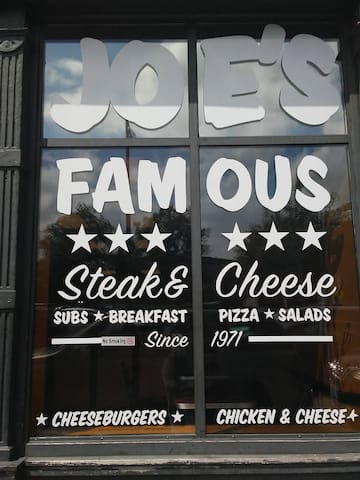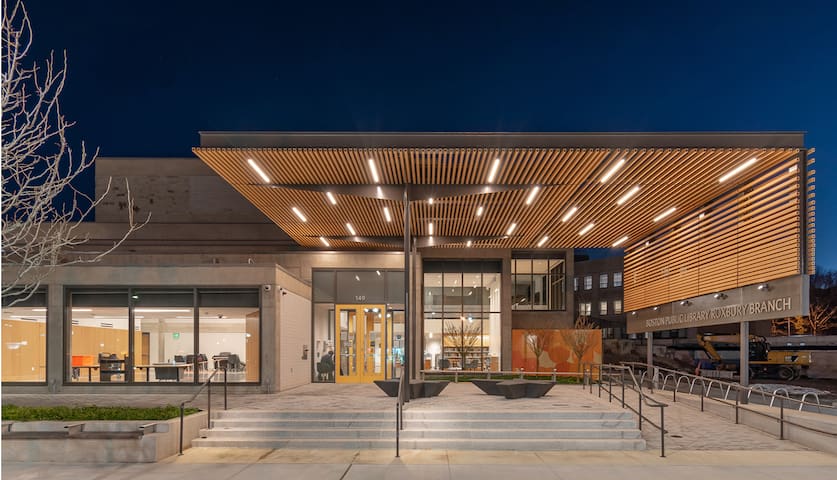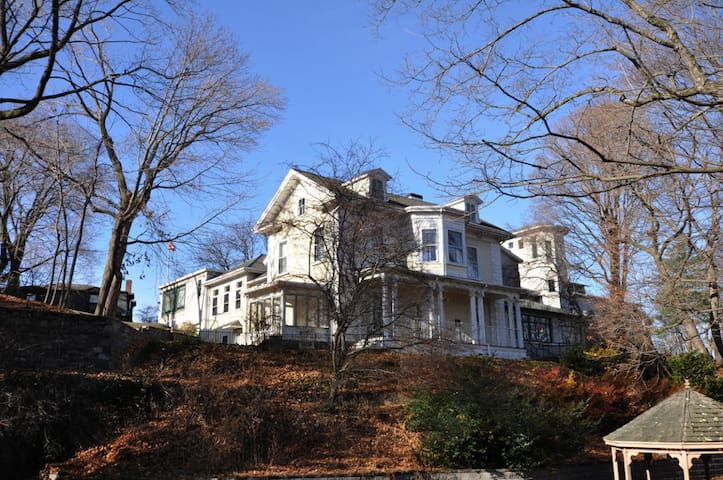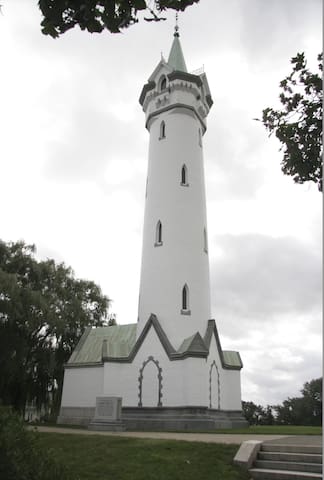Food Scene
Our Neighborhood's beloved greasy spoon diner where everybody knows your name. Locals from 50 years back congregate at the Silver Slipper. Home cooking, diner-style for the locals and beyond... CASH ONLY!
(5 min walk).... {Black-Owned}
Silver Slipper Restaurant
2387 Washington StOur Neighborhood's beloved greasy spoon diner where everybody knows your name. Locals from 50 years back congregate at the Silver Slipper. Home cooking, diner-style for the locals and beyond... CASH ONLY!
(5 min walk).... {Black-Owned}
Get there early... (5:30pm-6:00pm or make reservations) Great scene, Great small plates, Great Cocktails! Created by James Beard award willing chefs, the menu features barcelona-inspired small plates and classic inspired cocktails with a curated wine-list. (20 minute walk) (7 minute drive)
168 lokal ang nagrerekomenda
Toro Boston
1704 Washington StGet there early... (5:30pm-6:00pm or make reservations) Great scene, Great small plates, Great Cocktails! Created by James Beard award willing chefs, the menu features barcelona-inspired small plates and classic inspired cocktails with a curated wine-list. (20 minute walk) (7 minute drive)
A West African culinary concept with local appeal! Sometimes Suya Joint has live music and a band....
One of the most popular dishes is their Jollaf Rice. Check their website for suitable dishes for you in terms of flavor, spice and heat.
A caveat: The service can be on the slower side, so plan accordingly...
Walking distance (10 minutes). {Black & Female-owned}
6 lokal ang nagrerekomenda
Suya Joint Restaurant
185 Dudley StA West African culinary concept with local appeal! Sometimes Suya Joint has live music and a band....
One of the most popular dishes is their Jollaf Rice. Check their website for suitable dishes for you in terms of flavor, spice and heat.
A caveat: The service can be on the slower side, so plan accordingly...
Walking distance (10 minutes). {Black & Female-owned}
Dudley Cafe is an independent, locally owned business committed to serving the freshest locally sourced coffee & food to the Roxbury Community.
Dudley Cafe offers salads, sandwiches and meals with an Indian slant. (Great for grab and go). It has been a Community gathering space for meet-ups and afterwork functions and events.
(6 minute walk) (3 minute drive)
29 lokal ang nagrerekomenda
Dudley Cafe
15 Warren StDudley Cafe is an independent, locally owned business committed to serving the freshest locally sourced coffee & food to the Roxbury Community.
Dudley Cafe offers salads, sandwiches and meals with an Indian slant. (Great for grab and go). It has been a Community gathering space for meet-ups and afterwork functions and events.
(6 minute walk) (3 minute drive)
An inspired Italian neighborhood restaurant preparing food and engaging with community- a place that highlights the value of a good meal shared between friends. {Black-Owned, Award-Winning Chef}
(21 minute walk) (6 minute drive)
16 lokal ang nagrerekomenda
MIDA
782 Tremont StAn inspired Italian neighborhood restaurant preparing food and engaging with community- a place that highlights the value of a good meal shared between friends. {Black-Owned, Award-Winning Chef}
(21 minute walk) (6 minute drive)
Founded by pastry chef Joanne Chang, you'll discover some of the best pastries in Boston. Eclectic breakfast & lunch selection. Great coffee. Vegan Options. {Asian & Female-owned; Award-winning}
(22 min walk) (7 minute drive)
180 lokal ang nagrerekomenda
Flour Bakery
1595 Washington StFounded by pastry chef Joanne Chang, you'll discover some of the best pastries in Boston. Eclectic breakfast & lunch selection. Great coffee. Vegan Options. {Asian & Female-owned; Award-winning}
(22 min walk) (7 minute drive)
Milkweed is an American bistro that boasts a breakfast, lunch, and dinner menu. The restaurant is known for its Brunch and serves beer, wine, and a handful of cocktails after 11 a.m. (13 minute walk) (6 minute drive).
19 lokal ang nagrerekomenda
Milkweed
1508 Tremont StMilkweed is an American bistro that boasts a breakfast, lunch, and dinner menu. The restaurant is known for its Brunch and serves beer, wine, and a handful of cocktails after 11 a.m. (13 minute walk) (6 minute drive).
Chilacates is an authentic Mexican street food experience with the freshest, most local and natural ingredients that are available. (12 minute walk) (4 minute drive).
Chilacates Mission Hill
1482 A Tremont StChilacates is an authentic Mexican street food experience with the freshest, most local and natural ingredients that are available. (12 minute walk) (4 minute drive).
Ugis Subs
68 Warren StNeighborhood Sub shop....Best Steak & Cheese Sub in the City.
(5 minute walk)
Neighborhood Sub shop- Also arguably the best steak & cheese sub in the City!
Honorable menu mention: Pizza.
(5 minute walk)
Joe's Famous Steak Subs
140 Dudley StNeighborhood Sub shop- Also arguably the best steak & cheese sub in the City!
Honorable menu mention: Pizza.
(5 minute walk)
The best locally made Ice Cream next to Brigham's!
(18 minute walk)
(8 minute drive)
298 lokal ang nagrerekomenda
J.P. Licks
659 Centre StThe best locally made Ice Cream next to Brigham's!
(18 minute walk)
(8 minute drive)
Walkable places to visit
Directly across from our Air BnB resides the First Church in Roxbury- the City of Boston's oldest standing meeting house.
First Church in Roxbury, built in 1804, is the oldest surviving wood-frame meetinghouse in Boston and is the fifth meetinghouse built on this site.
First Church Roxbury’s design is based on the meetinghouse at Newburyport, Massachusetts, constructed by master builder William Blaney. Throughout the 19th and early 20th century, First Church Roxbury prospered with an active congregation.
Much of how First Church looks today has its origins in the early 19th and early 20th centuries. The wall clock in the sanctuary is a replica of the clock the congregation bought in 1803 from Simon Willard, a prominent parishioner and well-known clockmaker (the original is on loan to the Willard House and clock Museum). The steeple bell, which weighs more than 1500 pounds, was bought in 1819 from the Revere Foundry in Canton.
The organ was purchased in 1883 from the Roxbury firm of Hook & Hastings and the pulpit, modeled after the pulpit in the First Church of Lancaster, was installed in 1888.
In 1913, Rev. James De Normandie dedicated the first four of the memorial plaques that hang prominently in the sanctuary. The steeple you see today was rebuilt in 1954 after a hurricane destroyed the original.
Putnam Chapel was built next to First Church In 1878.
However, in response to post-WWII challenges, the church evolved from a worshiping congregation to an urban ministry, providing social services to the community of Roxbury, and a space and forum for addressing issues of social justice.
As the largest gathering space in Roxbury, it has hosted civil rights leaders such as Martin Luther King Jr., John Lewis, and Mimi Jones.
In 2003, the UU Urban Ministry sold its downtown Boston office and constructed the Education and Justice Center at First Church to serve as the headquarters for Urban Ministry activities. The new center, which physically connects First Church with Putnam Chapel, features two floors of classrooms, a full kitchen, lounge, as well as as office space for UU Urban Ministry employees.
The First Church in Roxbury has recently installed a beautiful outdoor prayer garden within the Church Yard at 10 Putnam Street. The garden sits on the corner of Putnam and Roxbury Street and serves as a public meditation space.
(30 second walk)
(If you decide to visit- ask for Reverend Mary Margaret!)
6 lokal ang nagrerekomenda
First Church In Roxbury
10 Putnam StDirectly across from our Air BnB resides the First Church in Roxbury- the City of Boston's oldest standing meeting house.
First Church in Roxbury, built in 1804, is the oldest surviving wood-frame meetinghouse in Boston and is the fifth meetinghouse built on this site.
First Church Roxbury’s design is based on the meetinghouse at Newburyport, Massachusetts, constructed by master builder William Blaney. Throughout the 19th and early 20th century, First Church Roxbury prospered with an active congregation.
Much of how First Church looks today has its origins in the early 19th and early 20th centuries. The wall clock in the sanctuary is a replica of the clock the congregation bought in 1803 from Simon Willard, a prominent parishioner and well-known clockmaker (the original is on loan to the Willard House and clock Museum). The steeple bell, which weighs more than 1500 pounds, was bought in 1819 from the Revere Foundry in Canton.
The organ was purchased in 1883 from the Roxbury firm of Hook & Hastings and the pulpit, modeled after the pulpit in the First Church of Lancaster, was installed in 1888.
In 1913, Rev. James De Normandie dedicated the first four of the memorial plaques that hang prominently in the sanctuary. The steeple you see today was rebuilt in 1954 after a hurricane destroyed the original.
Putnam Chapel was built next to First Church In 1878.
However, in response to post-WWII challenges, the church evolved from a worshiping congregation to an urban ministry, providing social services to the community of Roxbury, and a space and forum for addressing issues of social justice.
As the largest gathering space in Roxbury, it has hosted civil rights leaders such as Martin Luther King Jr., John Lewis, and Mimi Jones.
In 2003, the UU Urban Ministry sold its downtown Boston office and constructed the Education and Justice Center at First Church to serve as the headquarters for Urban Ministry activities. The new center, which physically connects First Church with Putnam Chapel, features two floors of classrooms, a full kitchen, lounge, as well as as office space for UU Urban Ministry employees.
The First Church in Roxbury has recently installed a beautiful outdoor prayer garden within the Church Yard at 10 Putnam Street. The garden sits on the corner of Putnam and Roxbury Street and serves as a public meditation space.
(30 second walk)
(If you decide to visit- ask for Reverend Mary Margaret!)
The Dillaway-Thomas House sits on the grounds of the Roxbury State Heritage Park and is an example of how State investment can create an opportunity in telling a rich and full history of Boston extending to all neighborhoods, not just downtown.
While we know the rich tales of Boston’s Revolutionary history on the Freedom Tail, the story is bigger and goes far beyond the colonial era. celebrating and bringing attention to historic places throughout the city which are a central part of our shared heritage.
After the war, the house’s ownership transferred to Charles K. Dillaway, an esteemed educator who later served as the superintendent of Roxbury schools. He and his wife, Martha, used the house as a “women’s day school and home for international students."
Almost demolished in 1927, the Roxbury Historical Society and local residents successfully fought to save and preserve the building. It became a museum in the 1930s and has undergone several renovations over the past century.
In 1992, it became the headquarters for the Roxbury Heritage State Park.
The Dillaway-Thomas House continues to serve as a space for exhibits and community meetings, many of which center on Black history and issues.
(2 minute walk)
6 lokal ang nagrerekomenda
Dillaway-Thomas House-Roxbury
183 Roxbury StreetThe Dillaway-Thomas House sits on the grounds of the Roxbury State Heritage Park and is an example of how State investment can create an opportunity in telling a rich and full history of Boston extending to all neighborhoods, not just downtown.
While we know the rich tales of Boston’s Revolutionary history on the Freedom Tail, the story is bigger and goes far beyond the colonial era. celebrating and bringing attention to historic places throughout the city which are a central part of our shared heritage.
After the war, the house’s ownership transferred to Charles K. Dillaway, an esteemed educator who later served as the superintendent of Roxbury schools. He and his wife, Martha, used the house as a “women’s day school and home for international students."
Almost demolished in 1927, the Roxbury Historical Society and local residents successfully fought to save and preserve the building. It became a museum in the 1930s and has undergone several renovations over the past century.
In 1992, it became the headquarters for the Roxbury Heritage State Park.
The Dillaway-Thomas House continues to serve as a space for exhibits and community meetings, many of which center on Black history and issues.
(2 minute walk)
The Roxbury Branch of the Boston Public Library is a 27,000 SF former Brutalist building revitalized into a bright, open and welcoming space for the community.
The largest portion of the renovation was for the main reading room. Other renovated spaces include a new Children’s corner, an African-American collection space, learning labs, a community room and new computer workstations.
A redesigned entry plaza features linear LED’s in the canopy/sunshade improving visibility and creating an architectural statement within the neighborhood.
During the warmer months, the entry plaza is activated with live music, festivals and local activities for all ages.
Dudley Branch of the Boston Public Library
149 Dudley StThe Roxbury Branch of the Boston Public Library is a 27,000 SF former Brutalist building revitalized into a bright, open and welcoming space for the community.
The largest portion of the renovation was for the main reading room. Other renovated spaces include a new Children’s corner, an African-American collection space, learning labs, a community room and new computer workstations.
A redesigned entry plaza features linear LED’s in the canopy/sunshade improving visibility and creating an architectural statement within the neighborhood.
During the warmer months, the entry plaza is activated with live music, festivals and local activities for all ages.
The William Lloyd Garrison House, also known as Rockledge, is a National Historic Landmark house, located at 125 Highland Street in the Roxbury Highlands section of Boston, Massachusetts.
Probably built in the 1840s or 1850s, it is significant as the longtime home of William Lloyd Garrison (1805–1879), one of the most high-profile abolitionist activists of the mid-19th century United States. Garrison published The Liberator, the principal organ of the abolitionist movement, and spoke for the immediate emancipation of slaves.
Despite significant later alterations to accommodate institutional uses, the building has retained much of its 19th-century fabric. It was designated a National Historic Landmark in 1965 and is a Boston Landmark.
William Lloyd Garrison (1805–1879) was born in Newburyport, Massachusetts, trained as a printer, and was from an early date involved in the anti-slavery cause. In 1830 he began publishing The Liberator, which, despite a relatively modest circulation, became the leading publication of the abolitionist cause.
On its pages Garrison regularly called for the immediate emancipation of all slaves. His advocacy was uncompromising, and upset not only slave-holding interests, but also members of the moderately anti-slavery business community.
In 2012 the property, including the Garrison House, was purchased by Emmanuel College, which operates its Notre Dame campus there today.
William Lloyd Garrison House
125 Highland StreetThe William Lloyd Garrison House, also known as Rockledge, is a National Historic Landmark house, located at 125 Highland Street in the Roxbury Highlands section of Boston, Massachusetts.
Probably built in the 1840s or 1850s, it is significant as the longtime home of William Lloyd Garrison (1805–1879), one of the most high-profile abolitionist activists of the mid-19th century United States. Garrison published The Liberator, the principal organ of the abolitionist movement, and spoke for the immediate emancipation of slaves.
Despite significant later alterations to accommodate institutional uses, the building has retained much of its 19th-century fabric. It was designated a National Historic Landmark in 1965 and is a Boston Landmark.
William Lloyd Garrison (1805–1879) was born in Newburyport, Massachusetts, trained as a printer, and was from an early date involved in the anti-slavery cause. In 1830 he began publishing The Liberator, which, despite a relatively modest circulation, became the leading publication of the abolitionist cause.
On its pages Garrison regularly called for the immediate emancipation of all slaves. His advocacy was uncompromising, and upset not only slave-holding interests, but also members of the moderately anti-slavery business community.
In 2012 the property, including the Garrison House, was purchased by Emmanuel College, which operates its Notre Dame campus there today.
Sightseeing
ROXBURY HIGH FORT
The iconic Fort Hill Tower (standing 80 feet high) overlooks Roxbury from the top of historic Highland Park (158 feet above sea level), the location of a strategic fort during the American Revolution.
Originally designed in 1869 by Nathaniel Bradlee and called the Cochituate Standpipe, the Gothic Revival style tower stored water from Lake Cochituate in Natick for local residents.
Soon obsolete as a water tower when Roxbury was annexed by Boston, the structure and grounds fell into disrepair. Between 1895 and 1916 the firm of Olmsted, Olmsted, and Eliot made improvements to the property, including the addition of an exterior viewing balcony and the reconstruction of the quadrangular shape of the original fort.
In 2013, an extensive restoration effort was undertaken by the City of Boston. paying special attention to historically appropriate methods and materials. This included the removal of paint and the restoration of period-appropriate mineral coatings, replacement of window glazing, and repairs to the cast iron staircase, metal roof, and arched wood windows.
With exceptional attention to detail, the project team not only restored a unique, irreplaceable historic structure but also preserved a place essential to the collective memory of a Boston neighborhood.
Fort Hill Tower
22-98 Fort AvenueROXBURY HIGH FORT
The iconic Fort Hill Tower (standing 80 feet high) overlooks Roxbury from the top of historic Highland Park (158 feet above sea level), the location of a strategic fort during the American Revolution.
Originally designed in 1869 by Nathaniel Bradlee and called the Cochituate Standpipe, the Gothic Revival style tower stored water from Lake Cochituate in Natick for local residents.
Soon obsolete as a water tower when Roxbury was annexed by Boston, the structure and grounds fell into disrepair. Between 1895 and 1916 the firm of Olmsted, Olmsted, and Eliot made improvements to the property, including the addition of an exterior viewing balcony and the reconstruction of the quadrangular shape of the original fort.
In 2013, an extensive restoration effort was undertaken by the City of Boston. paying special attention to historically appropriate methods and materials. This included the removal of paint and the restoration of period-appropriate mineral coatings, replacement of window glazing, and repairs to the cast iron staircase, metal roof, and arched wood windows.
With exceptional attention to detail, the project team not only restored a unique, irreplaceable historic structure but also preserved a place essential to the collective memory of a Boston neighborhood.
Alvah Kittredge House, 1834, Roxbury, MA
Built for Roxbury alderman and Eliot Church deacon Alvah Kittredge (1798-1876), the Kittredge House is one of a handful of high style Greek Revival period wood frame houses remaining in Boston.
Originally positioned in the center of a large rural estate, the Kittredge House was also once home to prominent 19th century Boston architect Nathaniel Bradlee.
In the 1970s and 80s, it was home to the African American advancement organization Roxbury Action Program (RAP). The house was vacant from 1991-2011.
HBI purchased the property in 2011 and completed a $3.8 million rehabilitation in 2014. The renewed mansion now holds five two-bedroom residential units including two permanently designated affordable units.
(
Alvah Kittredge House
12 Linwood StreetAlvah Kittredge House, 1834, Roxbury, MA
Built for Roxbury alderman and Eliot Church deacon Alvah Kittredge (1798-1876), the Kittredge House is one of a handful of high style Greek Revival period wood frame houses remaining in Boston.
Originally positioned in the center of a large rural estate, the Kittredge House was also once home to prominent 19th century Boston architect Nathaniel Bradlee.
In the 1970s and 80s, it was home to the African American advancement organization Roxbury Action Program (RAP). The house was vacant from 1991-2011.
HBI purchased the property in 2011 and completed a $3.8 million rehabilitation in 2014. The renewed mansion now holds five two-bedroom residential units including two permanently designated affordable units.
(








